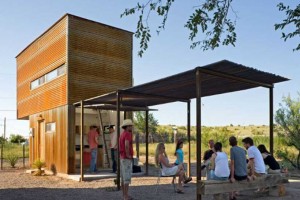I may get commissions for purchases made through links in this post.
Think those plastic PET bottle houses are mainly made by environmentally conscious outcasts and eccentric nuts living near landfills outside society? Think again. The following facts may surprise you.
Homes made from recycled plastic bottles, such as the typical round shaped Nigerian homes, are bullet-proof and earthquake resistant.
Oh, and they are fire-proof while keeping a snug year-round temperature of 64 degrees F. Even that’s not all, many are built to be energy self-sufficient too.
This idyllic farm house would fit perfectly in an authentic Southern European village. In reality it’s an Southern American, Ecoparque, Ecological House built with 8,000 bottles. Interesting detail, this bottle house is world’s first in its kind.
The Ecological House’s roof can weigh 30 tons when wet but does not need any other support than the bottle walls themselves. Surprisingly, this house features a solar water heating system and composting toilets and a solar water heating system.
Repurposing Used Beverage Bottles Into Useful Building Materials
Millions if not billions of plastic water and beverage bottles are discarded every year, with most making their way to landfills, the ocean, or, in poorer countries, disposed of in heaps.
In developing countries, this waste is often just mounded in garbage piles. In more wealthy nations, there are often recycling programs, which find ways to reutilize at least a portion of this waste stream which sounds great, in theory.
“The United States uses 129.6 Million plastic bottles per day which is 47.3 Billion plastic bottles per year. About 80% of those plastic bottles end up in a landfill.”
In recent years, most notably in Africa (Nigeria) and in Central and South America, initiatives have been taken to turn plastic beverage bottles into building materials. In Nigeria alone, where 500 million plastic beverage bottles are discarded each year, there’s plenty of material that can be repurposed for construction.
Firstly, bottles must be collected and sorted. About 14,000 bottles of uniform size are needed to make a two-bedroom bottle-home. In countries like Nigeria, bottles are donated by hotels, restaurants, foreign embassies, and residences. Obviously they are also collected on the garbage piles outside of villages.
The next material needed is sand. The sand is sifted through a sieve to remove leaves and foreign objects, and to provide a relatively uniform grain-size distribution. The plastic bottles filled and tightly packed with the sieved sand.
Once filled, the bottle becomes a “brick” of sorts that can be used as a basis with which to build a solid structure. It is said that once built, a wall made of so called “bottle bricks” is up to 20-times stronger than a wall constructed of concrete cinder blocks.
The Eco Nigeria bottle houses are solar powered, come with a fuel-efficient clean cook stove, water purification tanks and urine filtration fertilization systems making the homes “energy autonomous.”
Bottle Houses are Well-Insulated, Sturdy, and Cheaper
The sand inside the bottles makes excellent insulation that helps keep Nigeria’s tropical heat outside the walls of the house, and relative coolness inside. In a region often wracked by violence, the sturdy walls provide protection from stray bullets flying through the air. Moreover, for a region of the world where money tends to be scarce, the houses are estimated to cost 1/3 of a house made of concrete and bricks.

Eco-tec projects have a strong social focus. PET bottles are collected in recycling drives and clean-up campaigns after which the community fills them with sand. The unemployed and handicapped are trained in their construction methods. Besides homes, ECOTEC build schools, water tanks, community centers, and urban benches.
Bottle Houses are Easy to Build, and Have Eye-Appeal
Bottle houses are often more convenient to build in a circular fashion. The circular shape adds strength to the walls, while providing a very artistic and pleasing appearance. Any person with masonry skills can be used as labor in the construction of one of these homes.
Ordinary mortar is used to hold the “eco bricks” in place, as in regular masonry. Window frames and doorways can be accommodated in the construction, and windows and doors may be hung in these spaces, just like in normal construction. In Nigeria, corrugated metal is often the material of choice for roofing, nailed to wooden roof trusses erected over the house’s walls. The use of ‘eco bricks’ is used in Western transition towns too.
This Technology Can Also Have Applications Outside of the Third World
This building technology can have applications outside of the Third World. How about a sleep-away cabin on that parcel you own up in the mountains or out in the desert? How about a root cellar or storage shed?
How about a low decorative wall or raised garden bed in your back yard? There are a multitude of ways in which used plastic bottle “bricks” might add some pizazz to your home setting. You will add accent to your surroundings, while serving to reduce a waste stream and helping the environment. And it’s something completely different than that other form of recycled materiazrl homes; shipping container homes.
Going for the bottles? Do like Tomislav Radovanic, a retired Math professor from Serbia who has built a house of waste plastic. Except for the concrete foundation, the whole house is plastic, from gutters and windows to even repurposed plastic bottle furniture. Watch this short YouTube video for more info.
Great way to solve American homelessness?
Yes, if only the lack of housing were the problem. Amnesty International found that in 2011, empty houses in America outnumbered homeless families by five times. Still, a great way to build more sustainably, in or outside the US.
It’s not just an eccentric construction method for hippies and eco-warriors since the plastic bottle issue is a biggie. These bottles are polluting the world while they can be used to build homes for a fraction of the normal costs. You do have to bypass construction laws and find places without building codes though.
Wrapping it up
These homes are fire-proof, bullet-proof, well-insulated, affordable, easy to build and offer a solution to an ever growing pollution problem. So there you have it, your 8 reasons these houses rock.
Want to know more about building homes with trash (including a whole man-made island)?
Wanna know more about earthships and houses built with beer cans? Make sure to watch documentary #8 here too.
References
- Eco-Tec’s website www.eco-tecnologia.com
- Eco-Tec Frequently Asked Questions: www.eco-tec-solutions.com
- Green Nigeria
Images
- Greenhouse Owlsoup Photo on Flickr
- Ecological house argentina World Stroll
- Radovanic home Free Republic.

































Nice ideas!keep it up for the young children
I own a few plots of land in Bali and will be building something exactly like this. There is a big problem with plastic bottles there and will be put to good use now. Thanks for the idea’s
Great to see such innovations catching on. Success!
I believe that consumers in the United States might like the idea of using bottles to build their children outside playhouses or forts. These could go over big. If these could come packaged in kits with instructions- they might catch on.
Sir, can we have a chance to know who wrote this article?
xd
Be aware the bottles manufactured in the United States are required by law to deteriorate in less than 5 years. run a test. leave one in the sun for month, they get extremely brittle and will crumble into small specs. This will happen inside your walls you spent all that energy and hard work on. If you’re going to build a bottle wall, use glass bottles.
Actually that’s not true. Hypothetically bottles made of plastic will not deteriorate for over 450 years…even up to 1000. Making a plastic bottle to deteriorate in 5 would either mean it was made of organics or was putting insane amounts of chemicals in to the air. Bottled water is in fact considered to have an indefinite shelf life for example…so no…5 years is not at all correct.
Bottled water does not have an indefinite shelf life if it is in a plastic bottle. Over time, the plastic leaches into the water, and it becomes toxic.
You’re kidding right? The United States does not make bottles to deteriorate in 5 years. If it was true the landfills wouldn’t be filled with them.
Thanks a lot for this great article and yes constructing with plastic bottles is way more than cheaper as compare to concrete and i think it is robust too. It provides numerous advantages over concrete buildings.
Thank you for sharing this article.
I think the idea of repurposing plastic and glass bottles is a wonderful way to save money and waste while reaping these benefits to build with. However, since I am an engineer, I have to ask serious safety questions about the structures containing bottles. Especially the ones containing plastic bottles. Several sites have quoted strength values for these wall structures. They seem to promote superior strength to conventional wall construction methods. Well, who has the test data to support this contention? If this method is to be used safely without the risk of collapse and injury to the inhabitants, load testing to establish safe capacity must be done. Wishful thinking will not save your life or the lives of your loved ones. Who tested these structures for the bullet resistance? Someone in a third world country may give their life for that belief. Someone in America could do so as well at the rate violence is propagating. Do not let wishful thinking and unproven”common knowledge” create a false sense of security on these issues. Proof is required. Building codes are created for safety based on past failures. They may seem like they limit our creativity and rights, but no one has the right to create a structure which is unsafe. Everyone who enters is dependent on the builder’s ethics and credible building standards. Don’t let enthusiasm blind you to good building practice. Where is the load test data for this form of construction? Think about it and build safe. I like the ideas. I hope it turns out to be sound practice.
I understand your thinking. I am a retired attorney (20 years).
There is a way to do exactly what you ask.
Joe
Really!? Because the homes being built are soooo reliable and safe huh. My sister lives in a quarter of a million home which where we live it’s a lot and the roof collapsed with just a severe storm. Thank God no one was hurt but the possibility was there. These codes are made to benefit the rich and powerful not protect the people.
Wht r all tests should be connected to plastic bottles build
If the USVI had started preparing to recycle the billions of individual water bottles collected during hurricane recovery of Irma & Maria, we’d have enough bottles to build a whole village for those left homeless from the storms on all 3 islands, plus make enough material to repair every road in the USVI. Our landfill would be in much better shape if this Territory would get Serious about the 3R’s- RECYCLE, REUSE, REDUCE!!!!